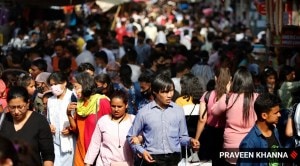- India
- International
Cattle Breeding Policy: Desi breed conservation should not be at expense of farmers, milk output
Lobbies with no stakes in dairy husbandry are undermining the achievements of crossbreeding through false glorification of the Indian cow.
 An artificial insemination worker bringing frozen semen to a dairy farm near Anand, Gujarat. (Photo: Bhupendra Rana)
An artificial insemination worker bringing frozen semen to a dairy farm near Anand, Gujarat. (Photo: Bhupendra Rana)
Livestock is an important asset for Indian farmers to supplement their agricultural income. Cattle and buffaloes have been traditionally maintained by them for milk production as well as manure and bullock supply. With 191 million cattle and 109 million buffaloes, India accounts for 30.3 per cent of the global bovine population. The country also tops in world milk output, with an estimated 155.5 million tonnes (mt) output in 2015-16.
However, India’s annual milk production per cow is only 1,310 kg, as against the world average of 2,200 kg and way below the 9,314 kg for the US and 10,035 kg of Israel. Such low milk yields are mainly because about 60 per cent of our cattle are genetically eroded nondescript animals. These animals, having no specific breed characteristics, produce just 350-500 kg of milk over an average annual lactation cycle. Out of the remaining 40 per cent, roughly 20 per cent comprises identified Indian cattle breeds with annual milk yields of 600-1,000 kg and another 20 per cent crossbred cows that produce 1,800-2,200 kg per year.
Read | Dairy dreams: A not-so-white vision
With rising farm mechanisation and use of chemical fertilisers, apart from rising feed and fodder costs, maintaining cattle and buffalo is today becoming uneconomical, unless the focus shifts to dairy husbandry as an economically viable and sustainable source of livelihood. But for that, it is necessary for farmers to keep animals yielding at least 1,200-1500 kg of milk per lactation. Currently, over 80 per cent of cattle in India are owned by some 70 million small and marginal farmers, a majority of whom rear nondescript cows. With an efficient breeding programme for improving the progeny of such animals, these poor farmers can adopt dairy husbandry as a reliable livelihood avenue.
Out of the 37 recognised indigenous breeds of cattle, only four — Gir, Red Sindhi, Sahiwal and Tharparkar — are true milch breeds, with their average milk yields at around 1,500 kg per lactation. Another seven breeds are of dual purpose, maintained both for dairy and draught functions, and with 800-1,200 kg annual milk yields. The rest 26 are primarily draught breeds, reared for producing bullocks and whose milk yields are well below 800 kg.
With the introduction of farm machinery and high cost of maintaining bullocks, neither nondescript nor draught breeds are economical propositions any longer for farmers. One needs to, then, promote a suitable cattle breeding and conservation policy, which enables small and marginal farmers to make the best use of their animals for raising incomes.

In 2012-13, the population of the four milch breeds, together with their upgraded progeny, was assessed at 11.29 million. Farmers would, no doubt, be happy to maintain such high-yielding animals. But on the other hand, the corresponding populations of the 7 dual-purpose and 26 draught breeds were11.76 million and 14.88 million, respectively. With decreasing demand for bullocks, farmers will prefer breeding the cows from these with bulls of the more profitable milch cattle breeds. This is already happening in buffaloes, where owners of Banni, Surti, Bhadawari and Pandharpuri breeds use Murrahbulls for producing more high milk-yielding progeny, without bothering to conserve the former breeds.
That leaves us with the estimated 113.25 million nondescript cattle, which are already under neglect due to low milk yields. Genetic improvement of their progeny by breeding with Indian dairy breeds has not been successful or, at any rate, attractive to farmers. Hence, crossbreeding with European dairy breeds such as Jersey and Holstein Friesian was promoted during the 1970s. As the crossbreds born to nondescript cows produced 2,000-2,400 kg milk per year, even marginal farmers started maintaining these animals and adopting dairy husbandry in a major way. Crossbred cows are what gave a boost to dairy husbandry, helping boost India’s annual milk production from 23.3 mt in 1973-74 to 155.5 mt in 2015-16, a near seven-fold jump in 40 years.
In spite of the above phenomenal success, many lobbies with no stakes in cattle rearing have been undermining the benefits of crossbred cows. The criticisms include the susceptibility of crossbreds to diseases and heat, besides the inability of their bullocks to carry out tillage operations. These apparent drawbacks, however, have hardly had any impact on farmers themselves. In recent years, there have also been attempts at pressurising the government to discourage crossbreeding by glorifying native cattle. This has involved, among other things, highlighting the use of their urine for plant protection and medicines, though without any economic considerations. False publicity has also been generated on the so-called harmful effects of the A1 type of milk produced by exotic breeds and crossbred cows
Recently, the agriculture ministry has published reports suggesting that A1 milk can induce diabetes and coronary heart disease. It has even released a poster, claiming that the A2 type milk produced by Indian cows is useful for treating these ailments. All these are based on a faulty study conducted in early 1990s in Australia, whose findings were not accepted due to lack of scientific validity. Moreover, people all over the world have been consuming A1 milk for centuries, without any documented ill-effects. Such baseless publicity and its seeming endorsement by the government will only destabilise India’s dairy development, causing huge losses to our farmers. The situation is further being encashed by traders, who are selling A2 milk at 200-300 per cent higher prices, even while consumers have no means of verifying its quality.
The danger is that in the absence of corrective action to counter misapprehensions over the safety and quality of milk from crossbred cows, farmers would be compelled to replace these with animals upgraded with native breeds. It may lead to their incurring an output loss of over 1,000 kg per cow per year, while also bringing down the country’s annual milk output by 35-45 mt. There’s no doubt that we need to conserve our native breeds of cattle. But any breeding policy has to protect farmers’ interests; we cannot force them to bear the burden of rearing low-productive cattle. The challenge is to make economic use of nondescript cattle, through crossbreeding them with exotic breeds and producing high-yielding progeny.
The benefits from such crossbreeding have been demonstrated by BAIF Development Research Foundation, a Gandhian organisation, for over the past 50 years. Over 40 lakh farmers in 15 states are at present availing the breeding services by BAIF. Crossbred cows born to low-yielding nondescript cows are yielding 2,000 kg and more of milk per year. A rural family can make a decent living even with three such high-yielding cattle. Farmers having a liking for indigenous cattle can opt for breeding crossbred cows with elite Indian breeds to maintain high milk yields along with positive traits of tolerance to heat and diseases. This is the strategy that Brazil adopted 100 years ago to improve production of imported Indian Gir cows. It helped them to increase the milk yield of these cows to 6,000-8,000 kg per year.
Currently, over 25million Indian farmers are maintaining crossbred cows. Adverse and baseless propaganda on the quality of milk from these animals can affect their incomes. The government must promote genetic conservation of native breeds, but any such policy measures should be science-based and definitely not at the cost of the farmer.
Must Read
Apr 19: Latest News
- 01
- 02
- 03
- 04
- 05






































